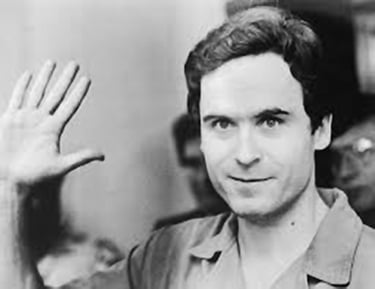

TrueCrime Tales
Gripping real-life stories of murder, mystery and justice. Step into the darker side of life with detailed, compelling narratives you won’t be able to put down.


TED BUNDY
“Handsome, Polite, and Pure Evil”
He was the kind of man you’d let carry your groceries. The kind of man who wore a crisp shirt, smiled when he spoke, and looked you right in the eye when he shook your hand. He helped strangers with flat tyres. He dated women who worked in law offices. He even volunteered at a suicide prevention hotline.
But Ted Bundy was also a predator — meticulous, manipulative, and utterly without empathy. He didn’t just kill; he hunted, tortured, and played with his victims like a child plays with dolls. He wore a mask for decades, and when it finally cracked, the monster behind it was unlike anything America had ever seen.
Born on November 24, 1946, in Burlington, Vermont, Ted was a child of shame. His mother was unmarried, and in the conservative 1940s, that was a problem. So his grandparents raised him as their own and introduced his mother as his older sister. For the first several years of his life, Ted lived in a house of lies — and deep in the background, there were whispers of physical and emotional abuse. Ted never forgot that betrayal.
As he grew up, he learned to pretend. He did it well. On the outside, he was bright, polite, and courteous. On the inside, he was festering with anger, jealousy, and a growing obsession with violence. By his teens, he was shoplifting compulsively, spying on women, and indulging in violent pornography — including photos of crime scenes and mutilated corpses. Friends said he was shy, but there were signs. He couldn’t form real connections. He mimicked others to fit in.
By the early 1970s, he was living in Seattle, Washington, attending the University of Washington, studying psychology. He dated a woman named Stephanie Brooks — a brunette with long dark hair parted in the middle. When she broke up with him, it seemed to spark something. He became obsessed with status, with appearance, with control. He re-enrolled, worked for the Republican Party, and applied to law school. He even got Stephanie back, just to dump her — coldly, without explanation.
Around this time, the murders began.
Women were disappearing from college campuses across the Pacific Northwest. They were all young. Slim. Brunette. Long hair, parted in the middle. They vanished from libraries, parking lots, public parks. Some were last seen with a man who had a broken arm or used crutches. He asked for help — lifting books, loading a sailboat, moving boxes.
That man was Ted.
Once inside his car — a tan 1968 Volkswagen Beetle — he would strike with a crowbar or a pipe hidden under the seat. He’d handcuff them, drive to a remote area, rape them, strangle them, and sometimes revisit their bodies to have sex with the corpses. Sometimes he would shampoo their hair. Apply makeup. Pose them like they were still alive. With at least one victim, he decapitated her and took the head home as a trophy.
In 1974 alone, he abducted and murdered at least a dozen women across Washington, Oregon, and Utah. The bodies were turning up in the forests — broken, violated, and half-buried in the undergrowth. Others were never found.
And still — he worked at a crisis hotline. He took calls from people who were suicidal. One of his colleagues, Ann Rule — a former police officer — would later write the definitive biography on him. She said, “There was something in his eyes. A deadness. A coldness that didn’t match the smile.”
Ted’s confidence grew with each murder. He began travelling further — Colorado, Idaho, Utah. His killing spree escalated. His methods became bolder.
In November 1974, 17-year-old high school student Laura Aime went missing in Salt Lake City. Her body was found a month later, badly beaten and violated. Days before that, 18-year-old Carol DaRonch had narrowly escaped — she got into his car after he flashed a fake police badge and claimed her car had been broken into. She noticed something was off. The car had no police radio. When he pulled over, she fought like hell. He tried to handcuff her — got both cuffs on the same wrist. She broke free, ran into traffic, flagged down a car, and lived.
That mistake would haunt him.
In August 1975, Bundy was pulled over in Utah. The officer found masks, handcuffs, rope, a crowbar, and a ski mask. Bundy claimed they were for skiing. But police were now suspicious. They began connecting dots across state lines. Carol DaRonch picked him out of a lineup.
He was convicted of attempted kidnapping in 1976 and sentenced to prison. But Bundy wasn’t finished.
In 1977, while awaiting trial for murder in Colorado, he exploited a gap in courtroom security and jumped out of a second-story window — spraining his ankle and disappearing into the Colorado wilderness. He survived off scraps, broke into cabins, and evaded search parties for six days before being caught.
But the most shocking escape came later that year. He sawed a hole in the ceiling of his jail cell, squeezed through into the empty apartment above, changed into a stolen suit, and walked out the front door. The guards didn’t discover he was gone for 17 hours.
By the time they realised, Ted was already in Florida.
What happened next was one of the bloodiest nights in American history.
In the early hours of January 15, 1978, Bundy entered the Chi Omega sorority house at Florida State University through an unlocked back door. He bludgeoned Margaret Bowman and Lisa Levy to death as they slept. He sexually assaulted both — biting Lisa so hard that the impression of his teeth was left in her skin. He then brutally attacked Karen Chandler and Kathy Kleiner — both survived, but were left with fractured skulls and lifelong trauma.
Bundy wasn’t done.
He broke into another apartment that same night and attacked Cheryl Thomas. She survived, but with permanent hearing loss and facial injuries. Then, on February 9, he abducted and murdered 12-year-old Kimberly Leach. Her body was found in a pig shed weeks later. It was the first time Ted had targeted a child.
On February 15, 1978, Bundy was finally arrested after being stopped for driving a stolen car. When the officer told him to get out of the vehicle, Bundy kicked him and ran. He was tackled and taken into custody.
This time, he wouldn’t escape.
His Florida trial became a national spectacle. Bundy represented himself, smirking through legal motions, cross-examining witnesses, and soaking up the attention. He proposed to Carole Ann Boone in the courtroom during a recess. She said yes. They even had a child together while he was on death row, through conjugal visits.
The evidence was overwhelming. Bundy was convicted and sentenced to death.
He spent nine years on death row, stalling his execution by confessing to more murders, offering information, and giving interviews. He eventually admitted to killing more than 30 women, but experts believe the true number could be double or triple that.
He said he was addicted to pornography. He said he couldn’t stop. In one chilling moment, he said, “We serial killers are your sons, your husbands. We are everywhere. And there will be more of your children dead tomorrow.”
On January 24, 1989, Ted Bundy was executed in the electric chair at Florida State Prison. He was 42 years old.
Outside the prison, crowds gathered with signs and T-shirts that read: “Fry Bundy.” Some cheered when the lights flickered from the jolt of electricity.
Inside, witnesses watched the smoke rise. Bundy’s face twisted in pain. And then… stillness.
He was gone.
But what he left behind — the horror, the heartbreak, the missing, the murdered, the women whose names we’ll never know — remains like a scar on the face of American history.
Bundy was the killer who looked normal. The killer who held babies and answered suicide hotlines. The killer who quoted law books and wore a suit to court. He was the man who proved you can never truly know what evil looks like — because sometimes, it wears a smile.
So the next time someone tells you that monsters don’t exist, remember this: they don’t always hide under the bed.
Sometimes they hold the door open for you.